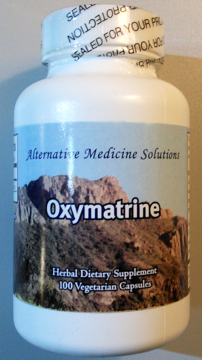Oxymatrine

Oxymatrine is one of several quinolizidine alkaloids extracted from the root of the Chinese herb Sophora flavescens (Ku Shen). Oxymatrine has immunomodulatory properties shown to combat enterovirus infections.
Oxymatrine biological effects[edit | edit source]
Oxymatrine has a number of biological effects:
- Oxymatrine acts as immunomodulator that increases antiviral Th1 cytokines (IFN-γ and IL-2), while reducing Th2 cytokines (IL-4 and IL-10).[1][2]
- Oxymatrine has potent antiviral effects on coxsackievirus B myocarditis in mice, markedly decreasing viral titers.[3]
- Oxymatrine reduces microglial activation, possibly by its inhibition of LPS-induced expression of TLR-4 and HSP60.[4]
Oxymatrine in the treatment of ME/CFS[edit | edit source]
Dr John Chia found in an informal study that 30% of ME/CFS patients will make major improvements with oxymatrine, and another 20% will make more minor improvements.[5] Dr Nancy Klimas is also reported to have given oxymatrine to 300 ME/CFS patients with similar success rates.[citation needed]
Dr Chia has formulated his own brand of oxymatrine called Equilibrant (which as well as oxymatrine, also contains other immunomodulatory herbs, but oxymatrine is the primary ingredient). This Chinese herbal supplement can be bought without prescription. In addition, oxymatrine is available as the White Tiger oxymatrine brand (200 mg per tablet) and Alternative Medicine Solutions oxymatrine (300 mg per capsule), which work with similar efficacy to Equilibrant. As Equilibrant is a proprietary blend, the exact quantity of oxymatrine in each serving of is not known. The Alternative Medicine Solutions oxymatrine website suggests an oxymatrine dose of 400 to 600 mg daily.
Oxymatrine treatment begins by taking half a tablet for the first week or two, then slowly increasing up to 2 or 3 tablets twice daily (so that means 4 or 6 tablets in total daily).[6] But the dose should not be escalated if there is significant increase in ME/CFS symptoms. Responders to oxymatrine should see signs of improvement by 4 to 6 weeks, but few may take more than 3 months.[7] Once the full benefits of oxymatrine have manifested, Dr Chia says men can stop taking it after 3 to 6 months (though elsewhere he says after 12 months);[7] however he finds women usually have to continue taking oxymatrine, otherwise they relapse and get worse again.[6] Dr Chia says inosine can be taken with oxymatrine in order to augment its effects.[5] Chia sometimes adds the antibiotic rifampin (also called rifampicin) 300 mg twice daily for 7 days to further boost the action oxymatrine.[8][5]
Dr Chia suggests that patients with autoimmune tendencies should not take oxymatrine, as there is a risk oxymatrine may trigger rheumatoid arthritis. Autoimmune tendencies means a family history of autoimmune diseases such as rheumatoid arthritis, lupus, autoimmune thyroiditis especially Graves' disease, multiple sclerosis, and if the patients have joint pain with positive rheumatoid factor and persistently positive ANA. Dr Chia says patients with known seizure disorders should not take oxymatrine.[5] Oxymatrine is probably best avoided in young children and during pregnancy.[9]
See also[edit | edit source]
Learn more[edit | edit source]
- Dr Chia: Oxymatrine
- Oxymatrine, Autoimmunity, ME/CFS and FM
- Quixotic: Equilibrant
- Invest in ME 2010 conference video (at 31:30 Chia talks about the oxymatrine treatment of ME/CFS)
- Invest in ME 2010 conference transcript
- Oxymatrine effects
- Immunomodulators info
- Dr Chia's oxymatrine patent
References[edit | edit source]
- ↑ Dong, YH; Xi, HL; Tian, F; Kang, AJ; Zhang, NL; Yu, M (2004). "Effects of oxymatrine on serum levels of Th1/Th2 type cytokines in HBsAg transgenic mice". Zhonghua Shi Yan He Lin Chuang Bing Du Xue Za Zhi (Chinese journal of experimental and clinical virology). 18 (3): 277–80. PMID 15640867.
- ↑ Dong, Y; Xi, H; Yu, Y; Wang, Q; Jiang, K; Li, L (2002). "Effects of oxymatrine on the serum levels of T helper cell 1 and 2 cytokines and the expression of the S gene in hepatitis B virus S gene transgenic mice: a study on the anti-hepatitis B virus mechanism of oxymatrine". J Gastroenterol Hepatol. 17 (12): 1299–306. PMID 12423275.
- ↑ Jiang, Y; Zhu, Y; Mu, Q; Luo, H; Zhi, Y; Shen, X (2017). "Oxymatrine provides protection against Coxsackievirus B3-induced myocarditis in BALB/c mice". Antiviral Res. 141: 133–139. doi:10.1016/j.antiviral.2017.01.013. PMID 28115196.
- ↑ Ding, F; Li, Y; Hou, X; Zhang, R; Hu, S; Wang, Y (2016). "Oxymatrine inhibits microglia activation via HSP60-TLR4 signaling". Biomed Rep. 5 (5): 623–628. doi:10.3892/br.2016.776. PMID 27882228.
- ↑ 5.0 5.1 5.2 5.3 Chia, J; Chia, A (2011), Rifampin augments the effects of oxymatrine in patients with myalgic encephalitis/chronic fatigue syndrome, International Association for Chronic Fatigue Syndrome/Myalgic Encephalitis (IACFS/ME)-Biennial International Conference
- ↑ 6.0 6.1 "MECFS Alert Episode 39 - Interview with Dr. John Chia, Part 2. See timecode 4:24". MECFS Alert.
- ↑ 7.0 7.1 Johnson, Cort (August 27, 2009). "Dr. Chia Produces Herbal Immunodulator – Oxymatrine".
- ↑ Calvin, Patrick W. (2013). "Quixotic ME blog, Summary of 4th appointment with Dr. C".
- ↑ Dharmananda, Subhuti (2005). "OXYMATRINE: Update on Clinical Effects and Safety". Institute of Traditional Medicine.

